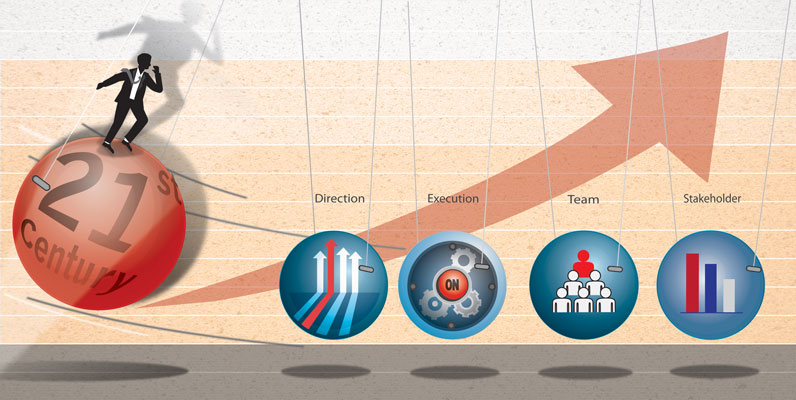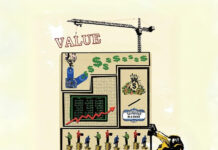From the earliest recorded leadership teachings of Confucius to contemporary theorists and practitioners, leadership has consistently been viewed as the decisive factor in the success of an organization – be they feudal clans, religious orders, militaries, governments, sports teams, or in today’s context, global commercial organizations. Leadership seems to be the secret sauce which differentiates organizations that languish through lackluster performance cycles and are saddled with uninspiring reputations from those inspiring organizations which repeatedly deliver high performance and earn best-in-class accolades.
Contemporary leadership defined
Leadership is the application of power and example to induce followers to pursue shared objectives which lead to fulfillment of security and survivability needs, and achievement of status aspirations.
Critics caution us to differentiate leader power from mere authority; noble service from self-indulgence or sinister pursuits; and stewardship from showmanship. But, without the power which galvanizes support, energizes, sets direction and controls, we might have amicable yet hungry followers sitting around campfires unable to fire up their iPad and unconcerned about quarterly financials. Leadership is the decisive factor in the success of organizations.
Corporate trap doors snare and derail even exceptional leaders
The playing field on which leaders operate each day tempestuously morphs and mutates. Unaware and unprepared leaders can be caught off guard by situations in which their previously learned lessons provide a faulty road map or no experience base to lead teams and formulate decisions. These situations are corporate trap doors which can open unexpectedly and treacherously to snare unprepared leaders. When these trap doors open, the risk of organizational drama and/or an exceptional executive’s derailment increases precipitously.
[ms-protect-content id=”9932″]Today’s leaders can find themselves on the defensive—on their heels–fighting for the hearts and minds of employees and other stakeholders, placing bets that corporate agility will deliver competitive advantage and risk mitigation tactics will safeguard their personal reputation and their company’s brand. Leaders rise to heightened expectations for transparency and this expectation has emboldened a new class of “watchers,” “second guessers,” plaintiff counsel, and compliance officers with adversarial intentions. Likewise, the workforce is diverse, talented, and ever more demanding.
Arguably, defensive skills, i.e., protective instincts, risk avoidance, and reactive agility are now on par with offensive skills, i.e., proactive risk taking, disruptive innovation, and the pursuit of market expansion as pivotal factors for success and survivability.
Exceptional leaders differentiate themselves from their unprepared cohorts by virtue of their instinct and skill in perceiving hazard and astutely adapting to changing demands and conditions of the playing field and expectations of stakeholders. This knack to transition between offense and defense rapidly, confidently and seamlessly, is adaptability. Adaptability is the ultimate differentiator. And, those leaders who fail to perceive, and then adapt, will certainly derail.
The battle some leaders wage today is one of striving to regain full control—getting back on their toes—and returning to an exclusively offensive mode of leadership. Regrettably, prospects for a return to predominately offensive-dominated operating strategies appear remote. Leaders relying too heavily upon their command and control competency and instincts will lose control and likely, derail.
Certain challenges are arguably within leaders’ direct realm of resolve and control. These require offensive tactics. Other challenges are outside leaders’ direct control. These require defensive tactics. Both sets of challenges present novel tests which repeatedly arrive unannounced in mutated form, require rapid, if not, crisis decision making competence, and always a dose of good fortune. Standard, “battle tested” game plans no longer can be relied upon.
Table 1, Challenges Faced by 21st Century Leaders, presents a daunting array of career-limiting challenges and threats faced by contemporary leaders as they contend with ever-tightening time windows, revolutionary change, mounting governmental intrusion, and new competitors armed with disruptive technologies and commodity pricing. As always, the leader’s goal is to improve his or her organization’s capability to react, survive, muster sustainable competitive advantage, and win against a competitive environment that continuously mutates. The “A” list of contemporary challenges which leaders must grapple with and is organized into two categories in Table 1:
• Proactive challenges. These are somewhat controllable and require proactive leadership tactics, and
• Reactive challenges. These challenges test leaders’ early warning instincts, rapid response mobilization, course correction skill, and savvy.
Stakeholders expect internal and external leadership competency
With the magnitude of change and its velocity, concepts about leadership need to be updated and refocused as a consequence of the changing conditions of the 21st Century. Historically, most leadership models have focused upon leaders’ roles in strategy planning, innovation, and the operational drive for performance. These matters are largely executed inside the organization. The external world is much more a dominant determinant in the 21st century. Thus, greater emphasis now must be placed on the external arena where influence, fueling ideas and connecting networks, as well as tactics to protect the reputation of the enterprise are essential for sustained performance of the enterprise, its reputation, and survivability of the leader.
The Model below represents this refocused view of 21st Century leadership.
Contemporary Leaders Fulfill Four Primary Roles
Dailey’s Executive Success Model, Figure 1, presents the primary roles essential for executive success within a contemporary, commercial enterprise. These four roles define an executive’s unique contribution to an organization’s mission and its array of stakeholders; its present and its future; its internal capability and its external reach and credibility. The four roles are explained below.
Set Direction
Exceptional leaders articulate a convincing case for change. They successfully chart a path forward with a committed coalition around them. Their organizations are alert to faint and game changing signals in the marketplace that indicate risk or opportunity, and have an astute sense of timing for moving forward (or standing firm). These organizations are rarely surprised and continuously invest in renewal—innovation is realized and change sticks. Importantly, leaders understand their risk tolerance levels and don’t bank on “magic bullet” strategies that put people, and the enterprise, in unreasonable jeopardy. These leaders get to the future before their competitors and bring an able, committed team with them. The direction is right; the timing is right; the risk is acceptable.
Execute the Plan
Exceptional leaders must also be exceptional managers. These leaders accelerate cycle time and their organizations hum along—they set a high bar and lead peer companies in productivity and operational effectiveness metrics. Leaders know the important control points in each of the operationally focused functions. Leaders earn respect from the astute questions they pose and the technical insight they offer. Top-down focus and control is balanced with bottoms-up listening and problem solving so breakdowns are understood, resolved, and continuous improvement is woven into the DNA of the operation. These organizations may not always be fun places to work, but they are superb places for learning to occur, teams to excel, and achievement to be earned.
Build the Team
Exceptional leaders attract, develop, inspire, and retain exceptional talent—and exceptional talent is expected to foster exceptional teams. Constructive conflict is expected to lead to collaboration, the pursuit of excellence, and pride. Destructive conflict is not tolerated. Contrarian views are allowed to rise to the top and be heard. Sentinels are not allowed to block or filter stakeholders’ ideas, issues, or sentiment from reaching the C-Suite. Yet, clear and timely decisions are made and implementation is expected. Leaders are visible symbols of character and competitive leadership in the marketplace. They teach and touch their emerging bench. Exceptional leaders decipher just how far, how fast, and how long organizations can be driven with their productivity and morale intact. Their teams win today’s competitive battles and have the reserve and resolve to come back tomorrow to compete again. Trust and respect are practiced and expected from the top of the organization downward.
Influence Stakeholders
Exceptional leaders act the part with solid impact, presentation, rapport and Q&A skills. They make promises and keep promises. Ethics and trust is table stakes for dealings with investors, employees, customers, and suppliers. The “whole truth” is offered and the “whole truth” is expected from others. Productive relationships and coalitions are long standing in their duration and treated as reliable conduits for information, insight, and support. These highly credible individuals keep their Boards informed and seek their advice—Boards are not dealt with as ceremonial bodies or rubber stamps of approval. These leaders are clear and simple with the media and regulators; they don’t attempt to out-duel or obfuscate. They are skilled in presenting their point of view and most often are influential in leading other opinion leaders to conclusion and/or action.
The prominence of this factor, Influence Stakeholders, has greatly intensified in the past 20-year period. Now, a company’s sustainability and corporate citizenship, ethics, board governance, and the executive’s role in protecting and enhancing the corporate brand, stand as equally important factors in evaluating an executive’s contribution and determining the leader’s survivability as do the traditional factors discussed above.
Executives have always represented their companies externally but now it matters decidedly more to shareholders and executives’ scorecards.
Temperament and critical thinking
At the core of the Model are critical thinking capabilities and temperament factors. These two elements serve as the foundation of one’s personality—and, this is the control center of each individual’s propensity to adapt and adjust. Critical thinking is the level of cognitive complexity and process used in perception as well as decision-making. Starting with the examination of context variables, each individual sets parameters for choices (i.e., decisions), gathers qualitative and quantitative data during an analytic phase, and weighs and ranks potential outcomes during decision making phase. Individual differences determine the pace (decisiveness) used to form a decision/ make a choice.
Temperament is mood; it is the relatively “hard wired” filter which individuals use to interpret and deal with life’s situations and experiences—often in vastly different ways from one another. Oft times, temperament is somewhat disguised or managed, but it remains a rather fixed “base layer” throughout our life. It is the foundation of personality. From this base layer, each individual opens up (or not) to experimentation and learning. Adaptive instincts, inclinations, and behaviors in varying degrees of comfort and mastery are learned and appropriately applied or individuals become dysfunctional and maladaptive.
A further breakdown of an executive’s role is presented in Figure 2, Executive Success: Key Competencies. The figure provides greater definition of the competencies supporting each of the four executive roles.
New Differentiators of Leader Success have emerged
Even with morphing and mutating challenges faced by 21st Century leaders, their success continues largely to be quantifiably measured by a short list of relatively unchanged operational and financial metrics—i.e. EPS, net income, total shareholder return and/or return on invested capital. These traditional measures are now joined by “new” measures intended to assess contemporary imperatives—good corporate governance, long term enterprise continuity and risk mitigation, air-tight statutory compliance, sustainability, and brand.
With the addition of contemporary measures of business success added to the traditional metrics and expectations, executives must now be equipped with a broader set of competencies than have been required previously.
Not surprisingly, new differentiators of executive success have emerged. A short list of these contemporary differentiators is discussed in Table 2. In many cases, these represent enhanced focus and attention by the executive. In the fulfillment of the Influencing Stakeholder role, decidedly new skills may need to be mastered and applied due to increasing demand that leaders be competent in working with and influencing investors, alliance partners, those controlling capital and credit channels, media, and government institutions wielding varying degrees of potential intrusion and regulation.
The competency factors, and the differentiators in Table 2, can be used for selection, focal points for coaching and development. These also can be assessed in the performance management process.
Summary
The Executive Success Model (Figure 1) offers a straight-forward presentation of the four primary roles that must be successfully fulfilled by senior executives in 21st Century commercial organizations. The Model balances…
• Long-range strategic intent (Set Direction) with daily operational focus (Drive Execution);
• Commercial pursuits (Set Direction + Drive Execution) with consideration for people, their values and needs (Build the Team + Influence Stakeholders); and
• Focus on external coalitions, shareholder and network alliances intended to protect and advance the brand (Influence Stakeholders).
The Model adds value to the contemporary study and practice of leadership due to its increased attention to Influencing Stakeholders. The external arena cannot be underestimated in its power to detour strategic pursuit, stall operational execution, and derail exceptional executives who choose to be inattentive to these external demands. The crucial importance of Board of Director relationships plus a challenging array of additional stakeholder engagements, transparency, ethical leadership, credibility, and constructive influence by senior executive(s) is acknowledged in the Model.
A strict prescriptive approach towards a 21st Century leadership model is folly. For 21st Century senior leaders to make that exceptional contribution, they must be comfortable and competent with their own adaptability and resist formulaic type-casting. They must oversee organizations which are likewise, adaptive. They must skillfully command and control internal processes, operations, and people; they must skillfully decipher faint signals and navigate the external arena.
The 21st Century path toward sustainable competitive advantage is guided by men and women of character and razor-sharp vigilance, who are able to invigorate their multinational, intergenerational clan along the path of rapid change, sustainable performance and, in Confucius terms, reach “collective harmony”.
About the author
Dr. Patrick R. Dailey is a founder of Board Quest, LLC. a board of director consultancy. Patrick has held senior level Human Resources positions in Fortune 100 firms… all undergoing significant strategic and cultural change. Dr. Dailey has worked in the technology sector for Hewlett-Packard and Lucent Technologies; consumer products for PepsiCo and Herbalife; chemicals and pharmaceuticals UK-based The BOC Group; and consulting for Korn/Ferry International and Chicago Change Partners, with the firm’s founder, Dr. Charles Bishop. Patrick serves on the Board of the National Association of Corporate Directors-Atlanta Chapter. He also serves as a director for a private business. He received a Ph.D. in Industrial and Organizational Psychology from the University of Houston, Texas, U.S.A. Patrick can be reached at pdailey@boardquest.com or 310.400.9992
[/ms-protect-content]











































